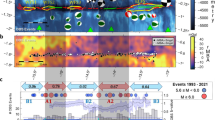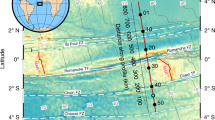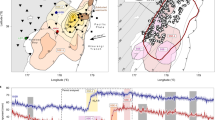Abstract
Oceanic transform faults that offset mid-ocean ridges slip through earthquakes and aseismic creep. The mode of slip varies with depth and along strike, with some fault patches that rupture in large, quasi-periodic earthquakes at temperatures <600 °C, and others that slip through creep and microearthquakes at temperatures up to 1,000 °C. Rocks from both fast- and slow-slipping transforms show evidence of interactions with seawater up to temperatures of at least 900 °C. Here we present a model for the mechanical structure of oceanic transform faults based on fault thermal structure and the impacts of hydration and metamorphic reactions on mantle rheology. Deep fluid circulation is accounted for in a modified friction-effective pressure law and in ductile flow laws for olivine and serpentine. Combined with observations of grain size reduction and hydrous mineralogy from high-strain mylonites, our model shows that brittle and ductile deformation can occur over a broad temperature range, 300–1,000 °C. The ability of seawater to penetrate faults determines whether slip is accommodated at depth by seismic asperities or by aseismic creep in weak, hydrous shear zones. Our results suggest that seawater infiltration into ocean transform faults controls the extent of seismicity and spatiotemporal variations in the mode of slip.
This is a preview of subscription content, access via your institution
Access options
Access Nature and 54 other Nature Portfolio journals
Get Nature+, our best-value online-access subscription
$29.99 / 30 days
cancel any time
Subscribe to this journal
Receive 12 print issues and online access
$259.00 per year
only $21.58 per issue
Buy this article
- Purchase on Springer Link
- Instant access to full article PDF
Prices may be subject to local taxes which are calculated during checkout




Similar content being viewed by others
Data availability
OTF mylonite and OBS deployment locations are provided in Supplementary Information Table 1. OTF mylonite compositional data is available at EarthChemLibrary48. The Gofar seismic data is available from the IRIS Data Management Center (https://www.fdsn.org/networks/detail/ZD_2007/). Source data are provided with this paper.
Code availability
The codes used to generate the thermal models, deformation mechanism maps and strength–depth profiles can be accessed at https://github.com/ahkohli/OTFs.
References
Wiens, D. A. & Stein, S. Age dependence of oceanic intraplate seismicity and implications for lithospheric evolution. J. Geophys. Res. 88, 6455–6468 (1983).
Chen, W.-P. & Molnar, P. Focal depths of intracontinental and intraplate earthquakes and their implications for the thermal and mechanical properties of the lithosphere. J. Geophys. Res. 88, 4183–4214 (1983).
Abercrombie, R. E. & Ekström, G. Earthquake slip on oceanic transform faults. Nature 410, 74–77 (2001).
Boettcher, M. S., Hirth, G. & Evans, B. Olivine friction at the base of oceanic seismogenic zones. J. Geophys. Res. 112, B01205 (2007).
McGuire, J. J. et al. Variations in earthquake rupture properties along the Gofar transform fault, East Pacific Rise. Nat. Geosci. 5, 336–341 (2012).
Roland, E., Lizarralde, D., McGuire, J. J. & Collins, J. A. Seismic velocity constraints on the material properties that control earthquake behavior at the Quebrada–Discovery–Gofar transform faults, East Pacific Rise. J. Geophys. Res. 117, B11102 (2012).
Wolfson-Schwehr, M., Boettcher, M. S., McGuire, J. J. & Collins, J. A. The relationship between seismicity and fault structure on the Discovery transform fault, East Pacific Rise. Geochem. Geophys. Geosyst. 15, 3698–3712 (2014).
Kuna, V. M., Nábělek, J. L. & Braunmiller, J. Mode of slip and crust–mantle interaction at oceanic transform faults. Nat. Geosci. 12, 138–142 (2019).
Froment, B. et al. Imaging along-strike variations in mechanical properties of the Gofar transform fault, East Pacific Rise. J. Geophys. Res. 119, 7175–7194 (2014).
Guo, H., Zhang, H. & Froment, B. Structural control on earthquake behaviors revealed by high-resolution Vp/Vs imaging along the Gofar transform fault, East Pacific Rise. Earth Planet. Sci. Lett. 499, 243–255 (2018).
Liu, Y., McGuire, J. J. & Behn, M. D. Aseismic transient slip on the Gofar transform fault, East Pacific Rise. Proc. Natl Acad. Sci. USA 117, 10188–10194 (2020).
Kohli, A. H. & Warren, J. M. Evidence for a deep hydrologic cycle on oceanic transform faults. J. Geophys. Res. 125, B017751 (2020).
Prigent, C., Warren, J. M., Kohli, A. H. & Teyssier, C. Fracture-mediated deep seawater flow and mantle hydration on oceanic transform faults. Earth Planet. Sci. Lett. 532, 115988 (2020).
Connolly, J. A. D. The geodynamic equation of state: what and how. Geochem. Geophys. Geosyst. 10, Q10014 (2009).
Guillot, S., Schwartz, S., Reynard, B., Agard, P. & Prigent, C. Tectonic significance of serpentinites. Tectonophysics 646, 1–19 (2015).
Fumagalli, P., Zanchetta, S. & Poli, S. Alkali in phlogopite and amphibole and their effects on phase relations in metasomatized peridotites: a high-pressure study. Contrib. Mineral. Petrol. 158, 723–737 (2009).
Chernosky, J. V. Jr, Berman, R. G. J. & Jenkins, D. M. The stability of tremolite: new experimental data and a thermodynamic assessment. Am. Mineral. 83, 726–738 (1998).
Hirth, G. & Kohlstedt, D. in Inside the Subduction Factory (ed. Eiler, J.) 83–105 (AGU, 2003).
Hansen, L. N., Zimmerman, M. E. & Kohlstedt, D. L. Grain boundary sliding in San Carlos olivine: flow law parameters and crystallographic-preferred orientation. J. Geophys. Res. 116, B08201 (2011).
Ohuchi, T. et al. Dislocation-accommodated grain boundary sliding as the major deformation mechanism of olivine in the Earth’s upper mantle. Sci. Adv. 1, e1500360 (2015).
Carter, N. L. & Avé Lallemant, H. G. High temperature flow of dunite and peridotite. Geol. Soc. Am. Bull. 81, 2181–2202 (1970).
Karato, S.-I., Paterson, M. & Fitzgerald, D. Rheology of synthetic olivine aggregates: Influence of grain size and water. J. Geophys. Res. 91, 8151–8176 (1986).
Chopra, P. N. & Paterson, M. S. The experimental deformation of dunite. Tectonophysics 78, 453–473 (1981).
Hirth, G. & Kohlstedt, D. L. Water in the oceanic upper mantle: implications for rheology, melt extraction and the evolution of the lithosphere. Earth Planet. Sci. Lett. 144, 93–108 (1996).
Fusseis, F., Regenauer-Lieb, K., Liu, J., Hough, R. M. & De Carlo, F. Creep cavitation can establish a dynamic granular fluid pump in ductile shear zones. Nature 459, 974–977 (2009).
Précigout, J., Prigent, C., Palasse, L. & Pochon, A. Water pumping in mantle shear zones. Nat. Commun. 8, 15736 (2017).
Getsinger, A. J. & Hirth, G. Amphibole fabric formation during diffusion creep and the rheology of shear zones. Geology 42, 535–538 (2014).
Tommasi, A., Langone, A., Padrón-Navarta, J. A., Zanetti, A. & Vauchez, A. Hydrous melts weaken the mantle, crystallization of pargasite and phlogopite does not: insights from a petrostructural study of the Finero peridotites, southern Alps. Earth Planet. Sci. Lett. 477, 59–72 (2017).
Hilairet, N. et al. High-pressure creep of serpentine, interseismic deformation, and initiation of subduction. Science 318, 1910–1913 (2007).
Platt, J. P. & Behr, W. M. Grain size evolution in ductile shear zones: implications for strain localization and the strength of the lithosphere. J. Struct. Geol. 33, 537–550 (2011).
Reinen, L. A., Weeks, J. D. & Tullis, T. E. The frictional behavior of lizardite and antigorite serpentinites: experiments, constitutive models, and implications for natural faults. Pure Appl. Geophys. 143, 317–358 (1994).
Moore, D. E., Lockner, D. A., Ma, S., Summers, R. & Byerlee, J. D. Strengths of serpentinite gouges at elevated temperatures. J. Geophys. Res. 102, 14787–14801 (1997).
Moore, D. E. & Lockner, D. A. Frictional strengths of talc–serpentine and talc–quartz mixtures. J. Geophys. Res. 116, B01403 (2011).
Cannat, M., Bideau, D. & Hébert, R. Plastic deformation and magmatic impregnation in serpentinized ultramafic rocks from the Garrett transform fault (East Pacific Rise). Earth Planet. Sci. Lett. 101, 216–232 (1990).
Constantin, M. Gabbroic intrusions and magmatic metasomatism in harzburgites from the Garrett transform fault: Implications for the nature of the mantle-crust transition at fast-spreading ridges. Contrib. Mineral. Petrol. 136, 111–130 (1999).
Aderhold, K. & Abercrombie, R. E. The 2015 Mw 7.1 earthquake on the Charlie–Gibbs transform fault: repeating earthquakes and multimodal slip on a slow oceanic transform. Geophys. Res. Lett. 43, 6119–6128 (2016).
Wolfson-Schwehr, M. & Boettcher, M. S. in Transform Plate Boundaries and Fracture Zones (ed. Duarte, J. C.) 21–59 (Elsevier, 2019).
Moyer, P. A., Boettcher, M. S., McGuire, J. J. & Collins, J. A. Spatial and temporal variations in earthquake stress drop on Gofar Transform Fault, East Pacific Rise: implications for fault strength. J. Geophys. Res. 123, 7722–7740 (2018).
Byerlee, J. Friction of rocks. Pure Appl. Geophys. 116, 615–626 (1978).
Stein, C. A. & Stein, S. A model for the global variation in oceanic depth and heat flow with lithospheric age. Nature 359, 123–128 (1992).
Behn, M. D., Boettcher, M. S. & Hirth, G. Thermal structure of oceanic transform faults. Geology 35, 307–310 (2007).
Dalton, C. A., Langmuir, C. H. & Gale, A. Geophysical and geochemical evidence for deep temperature variations beneath mid-ocean ridges. Science 344, 80–83 (2014).
Hartnady, C. J. H. & le Roex, A. P. Southern Ocean hotspot tracks and the Cenozoic absolute motion of the African, Antarctic, and South American plates. Earth Planet. Sci. Lett. 75, 245–257 (1985).
Roland, E., Behn, M. D. & Hirth, G. Thermal-mechanical behavior of oceanic transform faults: implications for the spatial distribution of seismicity. Geochem. Geophys. Geosyst. 11, Q07001 (2010).
Tasaka, M., Hiraga, T. & Zimmerman, M. E. Influence of mineral fraction on the rheological properties of forsterite + enstatite during grain-size-sensitive creep: 2. Deformation experiments.J. Geophys. Res. 118, 3991–4012 (2013).
Sibson, R. H. Frictional constraints on thrust, wrench and normal faults. Nature 249, 542–544 (1974).
Beeler, N. M., Hirth, G., Thomas, A. & Bürgmann, R. Effective stress, friction, and deep crustal faulting. J. Geophys. Res. 121, 1040–1059 (2015).
Kohli, A. H. & Warren, J. M. X-ray diffraction data on peridotite mylonites from the Shaka Transform Fault, Southwest Indian Ridge, Version 1.0 (Interdisciplinary Earth Data Alliance, accessed 13 August 2019); https://doi.org/10.1594/IEDA/111356
Acknowledgements
We thank C. Teyssier, S. Birner, K. Kumamoto, L. Hansen, M. Boettcher, M. Behn, J. McGuire and G. Hirth for helpful discussions. This work was supported by a NSF Graduate Research Fellowship to A.K. and NSF grants EAR-1347696, EAR-1619880 and OCE-1832868 to J.M.W.
Author information
Authors and Affiliations
Contributions
A.K., C.P. and J.M.W. performed analyses of the mylonite samples. M.W.-S. built the thermal models. C.P. conducted the geochemical measurements. A.K. performed the rheology calculations. All the authors discussed the results and contributed to writing the manuscript.
Corresponding authors
Ethics declarations
Competing interests
The authors declare no competing interests.
Additional information
Peer review information Nature Geosciences thanks the anonymous reviewer(s) for their contribution to the peer review of this work. Primary Handling Editor: Stefan Lachowycz.
Publisher’s note Springer Nature remains neutral with regard to jurisdictional claims in published maps and institutional affiliations.
Extended data
Extended Data Fig. 1 Deformation mechanism maps for Shaka transform fault.
Maps were generated using the flow law parameters in Extended Data Table 2. a, Protolith. b, HT mylonite. c, MT mylonite. d, LT mylonite.
Extended Data Fig. 2 Deformation mechanism maps for Gofar transform fault.
Maps were generated using the flow law parameters in Extended Data Table 2. a, Protolith. b, HT mylonite. c, MT mylonite. d, LT mylonite.
Extended Data Fig. 4 Modified friction-effective stress relationship for olivine and serpentine.
Modified friction-effective stress relationship for (a) olivine and (b) serpentine calculated using the Shaka geotherm (Fig. 2a) and hydrostatic pore fluid pressure (λ=0.4). The pore fluid factor, α, decreases from 1 at the surface to 0 at the brittle-ductile transition as the normal stress on asperity contacts nears the yield strength.
Supplementary information
Supplementary Information
Supplementary Fig. 1, discussion and Tables 1–4.
Source data
Source Data Fig. 1a
Oceanic transform fault locations, lengths, and slip rates.
Source Data Fig. 1e
Mineral chlorine concentrations in SWIR mylonites.
Source Data Fig. 2c
Calcium in orthopyroxene thermometry data.
Source Data Fig. 3b
Earthquake times, locations, and magnitudes from the 2008 Gofar OBS deployment.
Rights and permissions
About this article
Cite this article
Kohli, A., Wolfson-Schwehr, M., Prigent, C. et al. Oceanic transform fault seismicity and slip mode influenced by seawater infiltration. Nat. Geosci. 14, 606–611 (2021). https://doi.org/10.1038/s41561-021-00778-1
Received:
Accepted:
Published:
Issue Date:
DOI: https://doi.org/10.1038/s41561-021-00778-1
This article is cited by
-
Fluid-assisted grain size reduction leads to strain localization in oceanic transform faults
Nature Communications (2023)
-
Broad fault zones enable deep fluid transport and limit earthquake magnitudes
Nature Communications (2023)
-
Peridotites with back-arc basin affinity exposed at the southwestern tip of the Mariana forearc
Progress in Earth and Planetary Science (2022)
-
Deep hydration and lithospheric thinning at oceanic transform plate boundaries
Nature Geoscience (2022)



